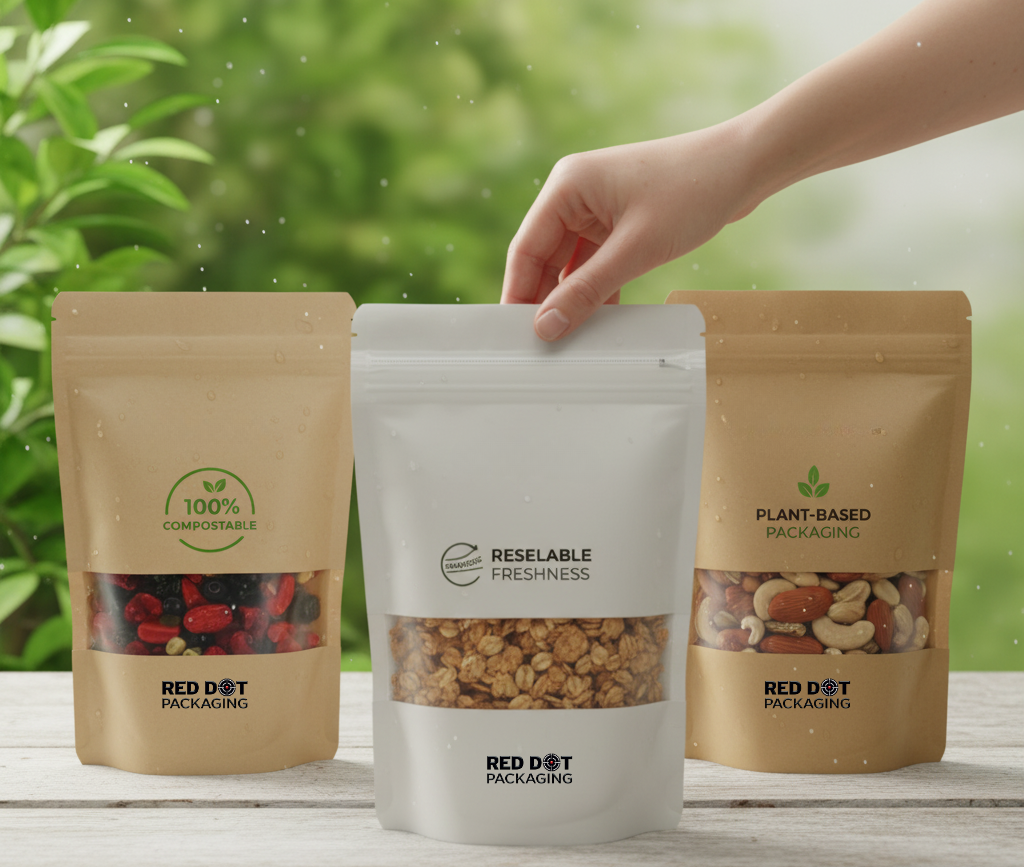Compostable Food Packaging: Resealable Pouches That Boost Consumer Appeal
Discover how compostable packaging, combined with resealable pouches, enhances sustainability, extends shelf life, and strengthens your brand’s consumer appeal.

Consumers are actively seeking brands that align with their values, particularly those that take meaningful steps to reduce environmental impact. At the same time, convenience remains non-negotiable. Shoppers want packaging that not only protects and preserves but also supports their lifestyle and reflects a brand’s commitment to the planet.
This shift in consumer behavior has driven a surge in demand for compostable packaging materials designed to break down naturally without harming the environment. But eco-friendliness alone isn’t enough. To truly win on the shelf and in the hands of consumers, packaging must also be practical and intuitive to use. That’s where resealable food pouches come in.
By combining the sustainability of compostable materials with the convenience of resealable pouches for food, brands can offer packaging solutions that check every box: earth-friendly, functional, and appealing. In this article, we’ll explore how this innovative fusion is not only meeting consumer expectations but also giving food brands a serious edge in today’s competitive market.
What Is Compostable Packaging?
Compostable packaging refers to materials designed to break down safely into natural elements such as water, carbon dioxide, and biomass under specific composting conditions, typically within a matter of months. Unlike traditional plastics, which can linger in landfills and oceans for centuries, compostable packaging leaves behind no harmful residues and contributes to a regenerative waste cycle when disposed of properly.
It’s essential to distinguish between compostable packaging and biodegradable and recyclable alternatives. While biodegradable materials eventually break down, the process is often undefined in terms of time or environmental conditions and can sometimes result in the formation of microplastics. Recyclable packaging, meanwhile, relies on existing recycling infrastructure which varies widely by location and doesn’t necessarily eliminate waste if not properly sorted or processed. Compostable packaging, on the other hand, is engineered to break down efficiently in industrial or home composting environments, providing a more predictable and environmentally friendly end-of-life solution.
Common materials used in compostable food packaging include:
- PLA (Polylactic Acid): A plant-based polymer typically derived from corn starch or sugarcane, offering clear film performance.
- Kraft Paper Laminates: Naturally biodegradable paper paired with a thin compostable barrier layer for strength and product protection.
- Cellulose Films: Made from wood pulp, offering excellent breathability and clarity, especially for dry foods.
- Compostable sealant layers: Used to maintain product integrity while still allowing the package to fully decompose.
Together, these materials form packaging that delivers the protection food products need while dramatically reducing environmental harm. By turning waste into nutrient-rich compost instead of landfill matter, compostable pouches lower the packaging carbon footprint and align with circular economy principles an increasingly important goal for both brands and the communities they serve.
Why Eco-Friendly Food Packaging Matters More Than Ever
Consumers Are Demanding Sustainable Alternatives
Today’s consumers aren’t just hoping for more sustainable options they’re actively choosing them. According to recent industry surveys, over 70% of consumers say they are more likely to purchase from brands that prioritize eco-friendly packaging. In the food sector especially, packaging is no longer just a container it’s a symbol of brand values. Buyers are reading labels, researching materials, and even paying premium prices for packaging that reflects their environmental priorities.
This consumer-driven momentum has made eco friendly food packaging a competitive differentiator, not just a nice-to-have.
Packaging Choices Directly Impact Brand Reputation
Brands that adopt compostable packaging are perceived as forward-thinking and responsible qualities that foster trust and brand loyalty. On the other hand, companies that continue to use traditional plastic or non-recyclable formats increasingly face public scrutiny, social media backlash, and reduced shelf appeal in markets where sustainability is a priority.
In this landscape, sustainable packaging is more than just a box to check it’s a core part of a brand's identity. Choosing compostable packaging demonstrates transparency, environmental care, and alignment with the values of a growing segment of eco-conscious consumers.
Supporting ESG and Corporate Sustainability Goals
With Environmental, Social, and Governance (ESG) frameworks gaining traction across industries, sustainable packaging decisions now carry weight at the boardroom level. Governments and retailers are also ramping up pressure, introducing bans on single-use plastics and setting sustainability targets that cascade down the supply chain.
Switching to compostable pouches allows brands to:
- Reduce reliance on fossil fuels and non-renewable materials
- Lower greenhouse gas emissions and landfill contributions
- Meet or exceed sustainability benchmarks and reporting metrics
By aligning with compostable solutions, companies not only future-proof their packaging strategy they also contribute to broader environmental progress while meeting regulatory and investor expectations.
Resealable Pouches for Food: The Functionality Consumers Love
A Smarter Way to Package Everyday Foods
Resealable food pouches are designed to be opened and closed multiple times, allowing consumers to keep products fresh without transferring them to separate containers. This convenience is especially valuable for snacks, dried fruits, powders, and pantry staples, where portion control, freshness, and portability are key.
Whether tossed into a gym bag, packed in a lunchbox, or stored in the pantry, resealable pouches give consumers more control over how and when they use a product. They’re a practical solution for today’s busy lifestyles, where on-the-go use and reduced food waste are increasingly important.
Variety of Closures to Fit Any Product
Not all resealable closures are the same. Brands can choose from several types depending on their product’s texture, weight, and usage habits. Common options include:
- Standard Zipper Closures: Simple and cost-effective, ideal for dry goods and lightweight snacks.
- Slider Zippers: Easy to open and close with one hand great for family-size products or accessibility needs.
- Hook & Loop (Velcro-style): Durable, tactile closures that provide a satisfying seal and are easy to align.
- Dual Track Zippers: Offer a more substantial barrier, often used for powdered products like protein mixes or coffee.
- Child-Resistant Zippers: Designed to comply with safety regulations for cannabis, supplements, and household items.
Each of these closures enhances the user experience, making the package feel more premium while supporting freshness and safety.
Enhancing Compostable Packaging with Practical Value
Integrating resealable features into compostable packaging might sound like a challenge, but it's a challenge worth solving. Resealability not only extends product freshness but also improves the usability of sustainable packaging, helping brands avoid the common pitfall of sacrificing function for eco-friendliness.
When resealable closures are engineered using compostable or compatible materials, the result is a high-performance package that truly meets modern expectations. At Red Dot Packaging, we specialize in pairing functional design with environmentally conscious materials delivering resealable pouches for food that are both easy to use and gentle on the planet.
How Compostable Resealable Food Pouches Boost Shelf Appeal
Elevated Aesthetics with Natural Finishes
In a competitive retail environment, first impressions matter. One of the standout benefits of compostable resealable pouches is their aesthetic versatility. With finishes like matte, natural kraft paper textures, and soft-touch coatings, brands can create a packaging experience that feels as premium as it looks. These tactile qualities not only enhance visual appeal but also communicate authenticity, craftsmanship, and a connection to nature qualities today’s shoppers respond to.
A compostable pouch with a matte or natural paper look offers an instantly recognizable cue: this product is environmentally responsible. That visual shorthand can influence purchasing decisions within seconds, especially for consumers scanning shelves for sustainable options.
A Canvas for Clean Labeling and Brand Storytelling
Beyond aesthetics, compostable food pouches offer an ideal canvas for clear communication and storytelling. Digital, flexographic, and rotogravure printing technologies enable brands to showcase high-resolution imagery and vibrant colors on natural substrates while maintaining simplicity and eco-awareness.
Minimalist, clean labeling not only aligns with sustainable branding but also helps communicate product benefits quickly. Additionally, the increased surface area of stand-up pouches allows for the inclusion of origin stories, sustainability commitments, composting instructions, or certifications all of which help reinforce trust and authenticity.
A Premium Experience Without Compromising Sustainability
Perhaps the most compelling advantage of compostable resealable packaging is its ability to deliver a high-quality consumer experience without sacrificing environmental responsibility. When customers pick up a pouch that feels sturdy, opens cleanly, and reseals reliably, it adds perceived value to the product inside. These functional details build positive associations that go far beyond the point of sale.
By combining sustainability with user-friendly design, brands show that going green doesn’t mean compromising on quality. Compostable resealable pouches offer a rare combination: elevated design, exceptional functionality, and a genuine commitment to reducing waste all in one package that consumers feel good about using.
Challenges and Innovations in Compostable Resealable Packaging
Key Barriers to Widespread Adoption
While compostable resealable pouches offer enormous potential, their adoption hasn’t come without challenges. One of the primary hurdles is cost. Compared to traditional plastic films, compostable materials typically come at a higher price point due to sourcing, certification, and lower economies of scale. For brands operating on tight margins or entering competitive markets, this can be a sticking point.
Durability is another concern. Compostable films can sometimes lack the toughness and puncture resistance of conventional plastics, making them less ideal for heavier or sharp-edged contents. Add in the technical complexity of resealable closures, and you’re dealing with a delicate balance between eco-responsibility and performance.
Finally, barrier properties such as protection against moisture, oxygen, and light must meet the demanding shelf-life requirements of many food products. Historically, this has been one of the most difficult aspects of compostable packaging to perfect.
Material Breakthroughs and Lamination Advances
Fortunately, rapid innovation is closing the performance gap. Recent developments in multi-layer compostable laminations have significantly improved strength, flexibility, and barrier protection. Brands can now access packaging made with PLA, cellulose, and compostable sealants that maintain food freshness while fully breaking down after use.
Specialized coatings and bio-based barrier layers are also enhancing moisture resistance and oxygen transmission rates, making compostable pouches increasingly viable for snacks, powders, and other sensitive contents.
When it comes to resealability, new compostable zipper options are now available that perform on par with conventional plastic tracks ensuring reliable closure without compromising end-of-life decomposition.
Market Applications: From Snacks to Supplements
Ideal Uses for Compostable Resealable Food Pouches
Compostable resealable pouches are an ideal solution across a wide range of food categories where freshness, convenience, and sustainability all matter. These pouches provide reliable protection for both dry and semi-moist products, while also offering a consumer-friendly design that encourages repeat use and fosters brand loyalty.
Common product categories benefiting from this packaging format include:
- Granola and Snack Mixes: These products benefit from resealable closures that keep ingredients crisp and flavorful, while compostable kraft finishes give them a clean, natural look that resonates with health-conscious consumers.
- Dried Fruits and Nuts: Compostable barrier layers protect against oxygen and moisture, preserving texture and taste.
- Spices and Seasonings: With strong aroma-locking properties, these pouches ensure spices stay potent and fresh, while offering portion control for frequent use.
- Herbal and Specialty Teas: Compostable pouches with soft-touch finishes and resealability add a premium touch to wellness products.
- Powdered Supplements and Superfoods: From protein powders to matcha and collagen blends, resealable compostable pouches offer secure sealing and easy portioning without compromising on brand aesthetics or sustainability.
- Pet Treats and Natural Foods: With increasing consumer demand for eco-friendly pet products, compostable pouches serve as a great match for natural or organic treats.
Real-World Success in Sustainable Packaging
At Red Dot Packaging, we’ve worked with brands in each of these categories to develop custom compostable pouch solutions that meet both product and brand goals. For example:
- A specialty granola company reduced its plastic footprint by over 85% by transitioning to compostable kraft laminate pouches with a zipper seal while improving shelf presence with natural matte print finishes.
- A wellness startup packaging adaptogenic powders partnered with Red Dot to create digitally printed compostable pouches with a resealable track that maintained product freshness and extended shelf life.
- An organic pet treat company switched from standard plastic to a compostable film structure with a hook-and-loop closure, helping them achieve their brand’s sustainability goals and increase customer retention thanks to the added convenience.
These real-world applications prove that compostable resealable pouches are not just a concept they’re a high-performing, commercially viable solution for brands ready to lead the future of food packaging.
Getting Started with Compostable Packaging
Key Considerations When Making the Switch
Transitioning to compostable resealable pouches is a smart investment in your brand’s future but it’s essential to approach it strategically. To ensure a smooth and successful launch, brands should start by evaluating a few critical factors:
- Run Size: Compostable materials can be cost-effective for both small and large batches; however, different printing methods (such as digital for short runs or flexo for mid-to-high volumes) may be better suited to your needs.
- Shelf Life Requirements: Not all compostable structures provide the same level of barrier protection. Products with moisture sensitivity, strong aromas, or longer shelf life demands may require specialized laminations or coatings.
- Machine Compatibility: If you’re running automated filling or sealing equipment, it’s essential to confirm that the compostable films and resealable components are optimized for your setup. Some adjustments may be necessary, especially with heat-sealing or form-fill-seal machines.
Working through these variables early in the process reduces delays, prevents costly errors, and ensures the final product performs exactly as intended from factory to consumer use.
Why Partnering with the Right Experts Matters
Compostable packaging isn’t just a design choice it’s a technical one. Materials, adhesives, laminations, and closures must work together seamlessly. That’s why partnering with an experienced packaging provider is crucial.
An expert team can help you:
- Select the right film structures for your product’s specific needs
- Ensure certifications for compostability (such as ASTM D6400 or EN 13432)
- Navigate regulatory considerations and label requirements
- Run compatibility checks with your current filling and sealing equipment
- Optimize print and finish options for shelf impact and brand storytelling
How Red Dot Packaging Supports a Confident Transition
At Red Dot Packaging, we make it easy to step into compostable solutions without compromising on performance or brand integrity. With decades of expertise in flexible packaging, we guide clients through every stage from concept and testing to full-scale production.
Our compostable packaging services include:
- Material consultation: Helping you choose the right compostable film and closure system for your product
- Custom prototyping: So you can test form, fit, and function before committing to larger runs
- Print flexibility: Including digital, flexo, and rotogravure options tailored to your volume and design
- Turnkey support: Coordinating artwork setup, compliance, and technical troubleshooting for machine runs
We understand that adopting new packaging technologies can be a complex process. That’s why Red Dot focuses on making the transition as smooth, efficient, and successful as possible so you can focus on growing your brand sustainably.
Conclusion
Compostable resealable pouches represent the future of food packaging, where sustainability, performance, and consumer satisfaction meet. They offer an elegant solution to modern demands: reducing environmental impact while maintaining the freshness, functionality, and visual appeal that today’s shoppers expect.
From granola to supplements, spices to pet treats, these pouches prove that going green doesn't mean sacrificing shelf appeal or product protection. With advanced materials, innovative closures, and high-quality print options, brands can now deliver packaging that aligns with their values and captivates their audience.
If your brand is ready to stand out, connect with eco-conscious consumers, and lead in sustainability, now is the perfect time to make the switch. Compostable, resealable packaging isn’t just a trend; it’s a strategic move toward a cleaner, more responsible future.
At Red Dot Packaging, we’re here to help you make that move with confidence.

Reach Out
Have questions? Need help? Reach out to us anytime! We're here to listen and assist.


